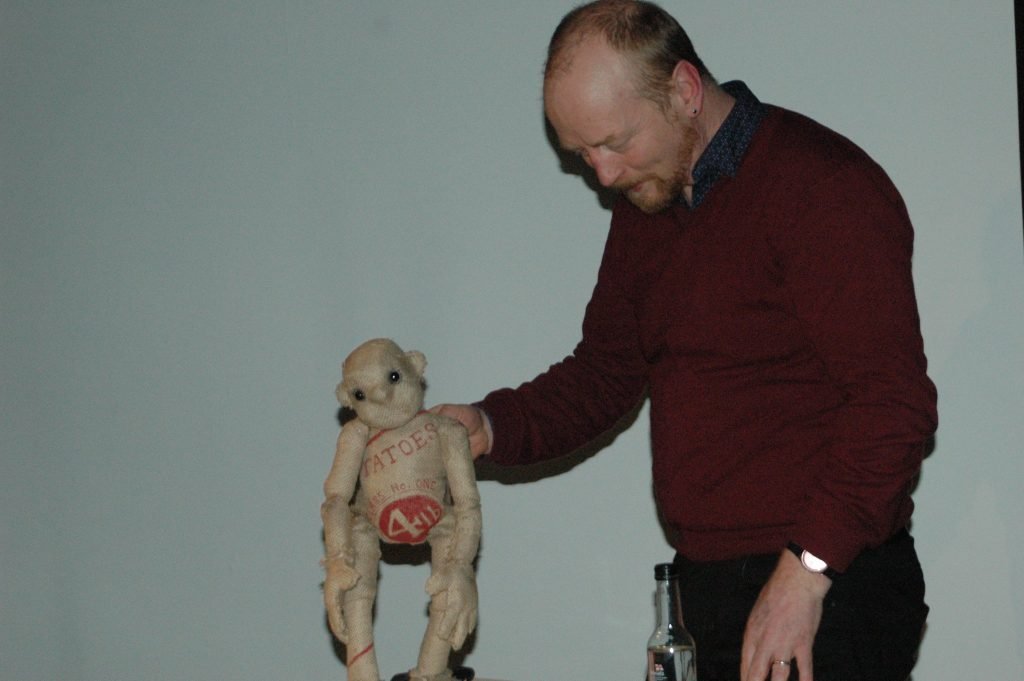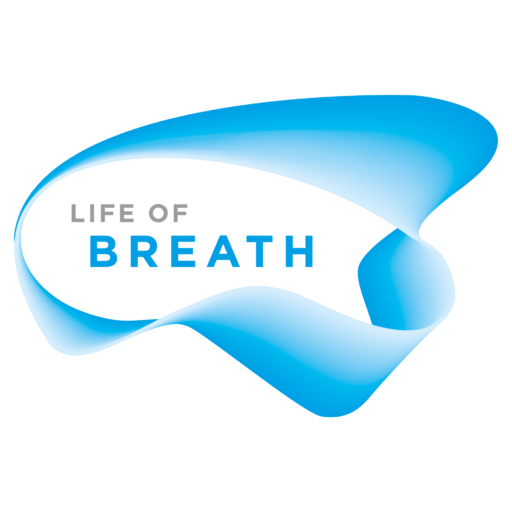Breath and Puppet
Header image: “Baby at Play” by Thomas Eakins, 1876. Puppeteer Chris Pirie was recently invited by LoB collaborator Elspeth Penny and LoB researcher Dr Alice Malpass to to speak at their event Gasp! Exploring Breath through Creative Arts as part of the Being Human festival (read a write-up of the evening by Alice Malpass here). Chris writes:
I have been focusing on my breath, and whilst doing so, have discovered some fascinating things about this involuntary activity that we do over 20,000 times a day. I now know that many people only think about breath when short of it; following physical exertion or when their airways are blocked due to a cold. I now know something about death doulas or soul midwives – people trained to offer comfort to the dying – and techniques they use to connect with and calm the anxious and erratic breath that often occurs towards the end, as life slips away…
I have also learned about a method that a talented street performer uses in building his physical comedy routines, carefully constructing gags around points of dramatic tension designed to entice his audience into holding their breath. He can then time the delivery of visual punchlines to coincide with their need to take another breath, which will invariably causes an automatic laughter.
And I have discovered that researchers at Northwestern University in Chicago are suggesting that breathing goes beyond an essential exchange of oxygen and CO2 for the brain and body, and may also organise the activity of multiple brain regions to help orchestrate complex behaviours. Their study also looked at how nose inhalation as opposed to the mouth, appeared to synchronise the activity of neurons in three key areas of the brain; the piriform cortex, hippocampus and amygdala; the parts associated with smell, memory, emotional behaviour and motivation.
But my own fascination with breathing goes back a bit further and stems from two places.
Firstly, I don’t do it very well. Along with an estimated 1 in 5 people I have obstructive sleep apnoea, meaning that every night I stop breathing for periods of time. As I sleep, the muscles around my airways and tongue relax, restricting the flow of air in or out. After a short period, my brain has to kick-start everything by signalling the muscles to tighten and allow the breath cycle to recommence. This can happen hundreds of times every single night, disturbing normal sleep cycles – which in turn affects the daily lives of 20% of the world’s population.
Secondly, I use breath awareness in my work; as a puppeteer and a teacher and director of puppetry for stage and screen.
Those of us that practice puppetry will often describe our craft as breathing life into, or giving breath to, inanimate objects. At one end of a scale, we employ fine motor skills to imbue a puppet with subtle micro-movement, enough to indicate life through the essence of air moving in and out of its tiny puppet lungs. And at the busier end of that same scale, we make our puppets do the most outrageous things; leap, or fly or float, explode, disappear, transform; anything a human actor who is confined by the physical laws of gravity, time and space would find impossible. And at various points between those extremes, we can maybe locate some cognitive and emotional capacity to indicate character. All of this is needs to be situated within a contract of imaginative engagement between the audience and performer. And at the heart of that contract is the grand shared conceit that somehow this bundle of wood, cloth, string, latex or whatever materials the particular puppet is made of, is actually receiving some of my breath so it too can breathe.
But being a purveyor of illusion and artifice is only half of the job description of the puppeteer.
The other half involves breath in a different capacity; more to do with the puppeteer than the puppet. As a director and teacher, I use breath awareness as a primary access point for helping anyone who is tasked with animating puppets. When I teach an introduction to performance puppetry, I often ask my students to take part in a very short exercise. I begin by asking them to pull an imaginary sock from a pocket, hold it in the air and slide their free hand inside all the way to end until…they each have an instant sock puppet. These puppets can now be given a simple sensory indicator of life, by having them look around the room, up at the ceiling, at all the lights, around the walls, and then back towards me.
I then introduce a second indicator; breath. With their own breathing steady and relaxed, I ask them to make their sock puppet seem to inhale also; firstly by opening its mouth slightly – using the thumb to represent the lower jaw, and then with a slight pull back of the wrist and inhaling through their nose, the puppet can ‘breathe in’ – followed by a short suspension of breath with its mouth closed, and then by reversing that movement – the students can exhale and make their puppet ‘breathe out’.
This is repeated, but this time the puppets will need to have the appearance of a slightly deeper breath, and will ‘hold it’ for a count of five before exhaling. I will then ask them to try one final time, to see if their puppet can hold its breath for 10 seconds. After a count of six or seven I ask them to freeze, then ask how many are still holding their own breath; invariably it is the entire group. As puppeteers, we need to remember that our little sock puppet character isn’t actually breathing; our job is to give the illusion of breath, using the sound of our breath cycle to signify inhalation and expiration, but to breathe normally in between.
I now want to briefly mention multi-tasking – something for which this ancient craft offers a good example. Puppetry can demand extreme focus, physical stamina and manual dexterity through fine motor skills. Puppeteers may be operating a puppet with others, needing calm complicity and close co-ordination of bodies and limbs of both performed and performer; all whilst recalling complex choreography and maintaining consistent eye gaze –so that one’s puppet appears to look where intended. When many of my students first encounter puppetry as a taught activity and try to accomplish such tasks simultaneously, they hold their breath. It’s a perfectly normal response, but one that has consequences; the potential to trigger a chain reaction through the entire body.
If you hold your breath, the heart rate rises, and carbon dioxide begins to accumulate in your cells, in your blood and lungs. This will eventually trigger impulses from the respiratory centres in your brain. These signals include strong and involuntary contractions of the diaphragm and the muscles in between the ribs designed to force you to draw breath. A tense diaphragm and abdominal muscles will limit breathing to the upper lungs. This can cause you to shift the upper chest, upsetting the normal involuntary adjustments to your centre of gravity and causing a sensation of your body becoming top-heavy.
Under normal conditions, your limbs, working in conjunction with your inner ears and clear signals from the brain, operate efficiently to maintain equilibrium with confident, automatic placement of your feet in relation to your centre of gravity. But with the breath held, these involuntary actions are now disrupted and result in hesitant, unsteady steps. These insecure movements can increase the likelihood of you ending up in an inefficient posture, off your centre of gravity. Your ability to engage any fine motor skills is compromised and you’re not only exposed to muscular injury but more importantly, now become uniquely capable of some pretty poor puppetry.
So, starting with a calm, deep and steady breath will help your body and brain to maintain a high level of functionality and awareness.
Breath awareness can be useful when working with another puppeteer on the same puppet. We can quickly establish efficient co-ordination in two ways: either listening to the breath of a colleague who amplifies the sound, or by making a point of physical contact; a spare hand on the centre-back or maybe where two arms meet, then one performer exaggerates the rise and fall of their ribcage. Either way, the rhythm of one person’s breath can be transmitted to the other and two breaths can be synchronized almost instantaneously. Subsequently, this facilitates synchronous movement; if a two-person puppet has to start walking, a subtle in-breath from the puppeteer who is controlling the head can signal an intention to start moving and at the same time, act as an amber traffic light to prepare their colleague controlling the feet. Then, on a coordinated outbreath – or a green traffic light – both parts of the body can move off in unison.
We can begin to understand how puppeteers can use an awareness and control of breath as a musician, dancer or athlete might, and be well placed to transmit that control through their hands, via strings, rods, cables or direct manipulation, into bringing a puppet to life. Much of my work as a puppetry director or teacher is working with self-declared novices to puppetry, so my task involves bringing a new-found awareness to breath, introducing them to the complexities of multi-operator puppetry through focus, fixed-point and intention, and then helping them to do it instinctively and naturally. Essentially this is about reminding them, many of whom are young actors fresh out of drama school, seeking to have ‘puppetry’ added to their CV, that this act of breathing life into an inanimate object, is essentially instinctive and is something they have all done before, only a long, long time ago.
Who has not spent countless hours as a child, playing with their dolls, teddy bears or action figures, moving them around, giving them voices and personalities, making them walk, fly, or swim or fight? For me, that is pure puppetry. And it is not taught to us by our parents or carers. It is encoded and innate. It is part of our DNA. And we were so good at it that we weren’t holding our breaths while we did it. We were all intuitive and highly skilled puppeteers from the moment we could first grasp an object and move it through space.
All that has happened is that – like breathing 20,000 times a day – we have forgotten to think about it.




